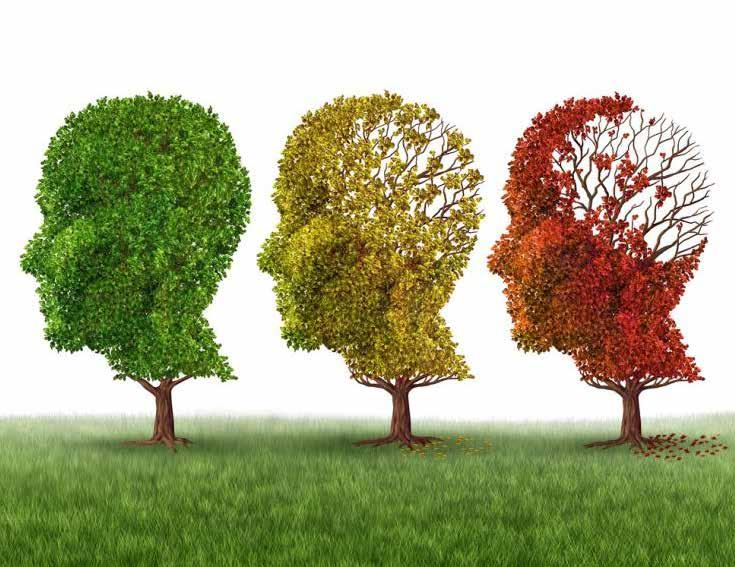
9 minute read
Dodging Dementia
A RECENT STUDY HAS IDENTIFIED AN ASSOCIATION BETWEEN LIGHTINTENSITY PHYSICAL EXERCISE IN OLDER ADULTS AND A REDUCED RISK OF DEMENTIA. THE STUDY, WHICH APPEARS IN “JAMA OPEN NETWORK”, LAYS THE GROUND FOR FURTHER RESEARCH TO DETERMINE WHETHER LIGHT-INTENSITY PHYSICAL EXERCISE CAUSES THE REDUCTION IN RISK.
Dementia is the term used to describe the symptoms of a large group of illnesses which cause a progressive decline in a person’s functioning. It is a broad term used to describe a loss of memory, intellect, rationality, social skills and physical functioning. There are many types of dementia including Alzheimer’s disease, vascular dementia, frontotemporal dementia and Lewy body disease. Dementia can happen to anybody, but it is more common after the age of 65. Although dementia can affect younger people, it is increasingly common with advancing age and mainly occurs among those aged 65 and over, but is not a normal part of ageing. Dementia is a major cause of disability and dependency among older people. It not only affects individuals with the condition, but also has a substantial impact on their families and carers, as people with dementia eventually become dependent on their care providers in most, if not all, areas of daily living.
Advertisement
How common is dementia?
The exact number of people with dementia in Australia is currently not known. It is estimated that in 2020 there are between 400,000 and 459,000 Australians with dementia (AIHW 2018; DA 2020), with Alzheimer’s disease accounting for up to 70 percent of diagnosed cases (DA 2018).
Risk factors
A range of factors are known to contribute to the risk of dementia and may affect the progression of its symptoms. Some risk factors can’t be changed, such as age, genetics and family history. However, several are modifiable, and can be altered to prevent or delay dementia. High levels of education, physical activity and social engagement are all protective against developing dementia, while smoking, hearing loss, depression, diabetes, hypertension and obesity are all linked to an increased risk of developing dementia (Livingston et al. 2017).
Impact
Dementia was the second leading cause of death in Australia in 2018, accounting for almost 14,000 deaths (ABS 2019). For females, dementia was the leading cause of death (nearly 9,000 deaths), while it was the third leading cause for males (nearly 5,000 deaths).
Australian statistics (January 2022)
• Dementia is the second leading cause of death of Australians • Dementia is the leading cause of death for women • In 2022, there are an estimated 487,500 Australians living with dementia. Without a medical breakthrough, the number of people with dementia is expected to increase to almost 1.1 million by 2058 • In 2022, there were an estimated 28,800 people with younger onset dementia, expected to rise to 29,350 people by 2028 and 41,250 people by 2058. This can include people in their 30s, 40s and 50s • In 2021, it is estimated that almost 1.6 million people in Australia are involved in the care of someone living with dementia • Approximately 70 percent of people with dementia live in the community • More than two-thirds (68.1 percent) of aged care residents have moderate to severe cognitive impairment.
Dementia risk reduction
Being brain healthy is relevant at any age, whether you are young, old or in between. However, it is particularly important once you reach middle age as this is when changes start to occur in the brain. While we cannot change getting older, genetics or family history, scientific research suggests that changing certain health and lifestyle habits may make a big difference to reducing or delaying your risk of developing dementia.
There are 12 recommendations for reducing risk for cognitive decline released by the World Health
Organisation: • Be physically active • stop smoking • eat a balanced diet, like the Mediterranean diet • drink alcohol in moderation • cognitive training • be socially active • look after your weight • manage any hypertension • manage any diabetes • manage any cholesterol • manage depression • look after your hearing and manage hearing loss.
More at
dementia.org.au
and
jamanetwork.com
Lose the booze

MANY OF US HAVE BEEN HOUSEBOUND OVER THE PAST FEW YEARS, LESS ABLE TO COMMUTE AND LESS INCLINED TO GET OUT AND ABOUT. PLENTY OF US HAVE GAINED “COVID KILOS” DURING LOCKDOWNS AND THE DISRUPTION TO OUR ROUTINES.
According to data from the Australian Institute of Health and Welfare, weekly alcohol spending rose between four and 24 percent between May 2020 to February 2021. A poll taken by ANU over the same time found 18.1 percent of females and 15.5 percent of males increased their alcohol consumption. The most common reason given for increased alcohol consumption was spending more time at home, followed by boredom and increased stress – or a combination of all three! Alcohol can cause weight gain in four ways: it stops your body from burning fat, it’s high in kilojoules, it can make you feel hungry and it can lead to poor food choices. Whether or not you personally gain weight from drinking alcohol depends on many factors. These include: your behaviours when you drink, what you drink, how often you drink, how much you drink, what you eat when you drink, factors that relate to your unique body and lifestyle, your overall diet, your genetics, your gender, your level of physical activity, your age and your health, for example the presence of other risk factors such as obesity and diabetes. Drinking alcohol, particularly in excessive amounts, has many other serious health risks beyond possible weight gain, including high blood pressure, high triglycerides, insulin resistance, heart disease, stroke, liver disease and some cancers. To reduce the risk of harm from alcoholrelated disease or injury, the National Health and Medical Research Council recommends men and women drink no more than 10 standard drinks a week (one standard drink equals 100ml - less than half a cup), and no more than four standard drinks on any one day. The less you drink, the lower your risk of harm from alcohol. Reducing or quitting alcohol can improve your life in many ways, including improving your mood and sleep, increased energy, improved relationships, better performance at work, lowering your risk of long-term health problems such as cancer and heart disease, and saving you money! Dietitians Australia recommends aiming for two alcohol-free days per week and drinking plenty of water to avoid dehydration. Other tips include alternating alcoholic drinks with non-alcoholic drinks such as water or soda water and avoiding snacking on foods high in salt. Not only is too much salt unhealthy, but it can also increase the likelihood of having another drink. Avoid pre-mixed drinks with added sugars. These are very high in both kilojoules and sugars.
Source: Smart Eating For You. Canberra, Australia. More at Alcohol & Drug Foundation
adf.org.au
Discovering a Plant-based Diet
THE WORDS VEGAN, VEGETARIAN AND PLANT-BASED TEND TO BE USED INTERCHANGEABLY BECAUSE THE PLANT-BASED DEFINITION IS A LITTLE VAGUE AND SUBJECTIVE.
A plant-based diet is a style of eating where plants form the basis of the diet yet animal products in all their forms aren’t omitted. As a dietitian, I am a huge advocate for a plant-based style of eating. After all, some of the most well researched and advantageous diets in the world are constructed around plants i.e The Mediterranean Diet. Most of us do need to prioritise including more plants in our diets but animal products do not have to be completely removed to lead a healthy lifestyle
When thinking of transitioning to a plant-based style of eating, the first thing to remember is that your mindset is everything. It’s important not to go into this new chapter with a closed, restrictive, guideline-driven mindset.
Plant-based eating is the exact opposite of that. It encourages you to incorporate more plants into your diet without being fixated on rules and restrictions.
Plant-based diets allow for ‘all-foods’ and are a sustainable and highly enjoyable way of eating. Don’t forget that!
For any lifestyle or dietary change to be maintainable, you must understand your ‘why’. In this case, why do you think it’s important to eat more plants? Is it to improve your gut health, your mental health, immune strength, disease risk, skin and sleep quality, environmental impact, animal welfare? There is no right answer, the purpose just has to align with you!
Secondly, think about all of the simple things you can do to slowly start implementing more plants in your diet. Remember, plant-based doesn’t necessarily mean excluding animal products all together, so before you become overwhelmed with the concept of plant-based, you don’t actually have to remove any foods. Knowing where to shop and what to put in your trolley doesn’t have to be too complicated. While I do prefer to shop local where I can, I appreciate that supermarket chains are the most convenient and accessible for most consumers. Thankfully, you can find everything you need for a well-balanced plant-based diet at traditional grocery stores.
When shopping, you don’t need to fill your trolley with expensive ‘fake-meats’ or ‘cashew cheeses’ and ‘vegan icecreams’ which are often expensive and lack nutritional value.
Instead, you can find all the nutrition you need in everyday household staples. Fill your trolley with fresh or frozen fruits and vegetables (both are just as nutritious), tinned or dried lentils and legumes, nuts and seeds (buy these in bulk to keep costs at a minimum), and whole-grains and cereals such as rice, pasta, rolled oats, quinoa, cous-cous, wholegrain breads and wraps.
I also think a great alternative to dairy milk is almond or oat milk, particularly a brand such as Inside Out, whose homegrown journey started in Sydney farmers markets and only uses Aussie almonds, oats and real ingredients with an abundance of nutritional value.
Here are a few places to start your journey:
Plan your meals at the start of the week and aim for 75 percent of the ingredients to be derived from a plant. Remember, plants don’t just equate to vegetables, they also cover fruits, nuts, seeds, lentils, legumes and wholegrains so get creative on how you can incorporate these types of foods into the meals you regularly cook at home.
If that is too much for you – substitute 50 percent of the meat with a plantbased alternative. You won’t be able to tell the difference.
Be smart with your snacks. Fill the fridge and pantry with plant-based snacks such as fresh/dried fruit, muesli bars with lots of wonderful grains/nuts/seeds, wholegrain crackers and dips made from legumes/vegetables (hummus and avocado varieties are my favourite) Start by swapping one animal-based ingredient at each main meal. sandwiches instead of mayonnaise and lastly, reduce my meat intake at dinner and make up the rest of the portion with a new vegetable or grain I haven’t tried.
Freekeh has been my new favourite grain as of late and I’m loving the nutty flavour and coarse texture it adds to my meals.
You may wish to try a fortified plantbased milk such as Inside Out’s Almond/ Oat Milk which contains the necessary vitamins and minerals you would find in traditional dairy-based milks.
Add plant-based milks to smoothies, breakfast bowls, in your home baked sweet treats or as a substitute to cream and/or milk in savoury pasta dishes or curries.
Lastly, your diet must be enjoyable to be sustainable. Start small and build on each goal as it becomes a habit.

For recipes and more information, visit dietitianedition.com and










